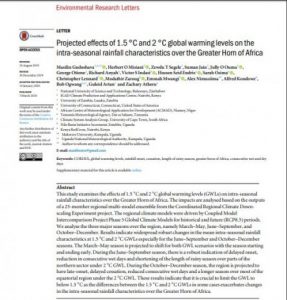Resource

Projected effects of 1.5 and 2 °C global warming levels on the intra-seasonal rainfall characteristics over the Greater Horn of Africa
Authors: Masilin Gudoshava, Herbert Misiani, Zewdu Segele, Suman Jain, Jully Ouma, George Otieno, Richard Anyah, Victor Indasi, Hussen Seid Endris, Sarah Emerald Osima, Christopher Lennard, Modathir Zaroug, Emmah Mwangi, Alex Nimusiima, Alfred Kondowe, Bob Ogwang, Guleid Artan and Zachary Atheru
Date: 2020
Type: Journal Article
Abstract:
This study examines the effects of 1.5 and 2 °C global warming levels (GWLs) on intra-seasonal rainfall characteristics over the Greater Horn of Africa. The impacts are analysed based on the outputs of a 25-member regional multi-model ensemble from the Coordinated Regional Climate Downscaling Experiment project. The regional climate models were driven by Coupled Model Intercomparison Project Phase 5 Global Climate Models for historical and future (RCP8.5) periods. We analyse the three major seasons over the region, namely March-May, June-September, and October-December. Results indicate widespread robust changes in the mean intra-seasonal rainfall characteristics at 1.5 and 2 °C GWLs especially for the June-September and October–December seasons. The March-May season is projected to shift for both global warming level scenarios with the season starting and ending early. During the June-September season, there is a robust indication of delayed onset, reduction in consecutive wet days and shortening of the length of rainy season over parts of the northern sector under 2 °C GWL. During the October-December season, the region is projected to have late onset, delayed cessation, reduced consecutive wet days and a longer season over most of the equatorial region under the 2 °C GWL. These results indicate that it is crucial to limit the global warming level to below 1.5 °C as the differences between the 1.5 and 2 °C GWLs in some cases exacerbates changes in the intra-seasonal rainfall characteristics over the Greater Horn of Africa.
